Economic Analysis Report: Analysis of Demand Elasticity Concepts
VerifiedAdded on 2020/12/30
|12
|2592
|487
Report
AI Summary
This report provides a comprehensive economic analysis of demand elasticity, exploring three key concepts: price elasticity, cross-price elasticity, and income elasticity of demand. Part A delves into the theoretical underpinnings of each concept, defining and illustrating them with examples, including the calculation of price elasticity and the different types of cross-elasticity. Part B applies these concepts within an organizational context, such as Walmart, examining how price changes, income levels, and the availability of substitute goods impact consumer demand. The analysis includes graphical representations and real-world examples to illustrate the practical implications of these elasticities in business decision-making, such as pricing strategies and understanding market dynamics. The report emphasizes the importance of these concepts for understanding consumer behavior and market responses to economic changes.
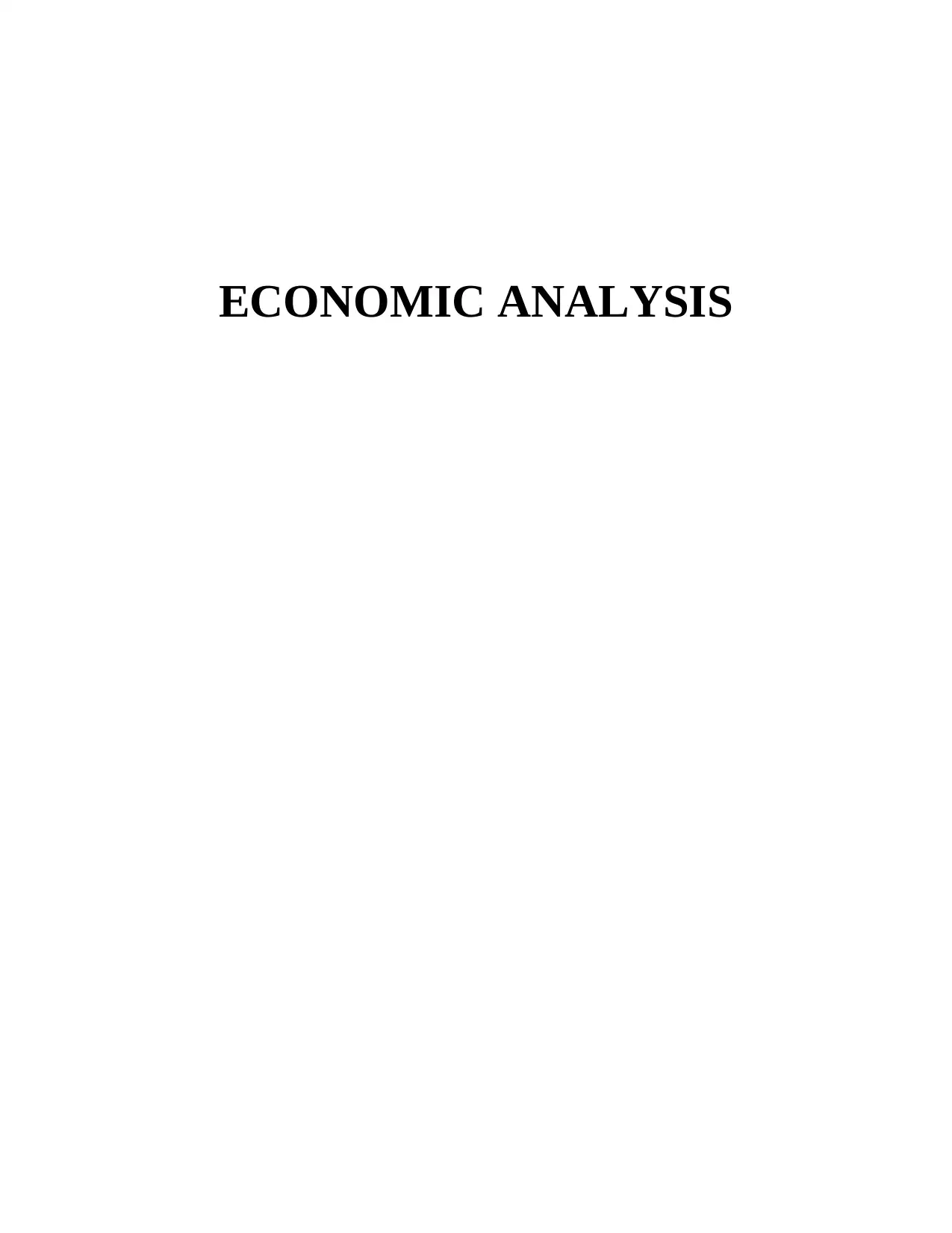
ECONOMIC ANALYSIS
Paraphrase This Document
Need a fresh take? Get an instant paraphrase of this document with our AI Paraphraser
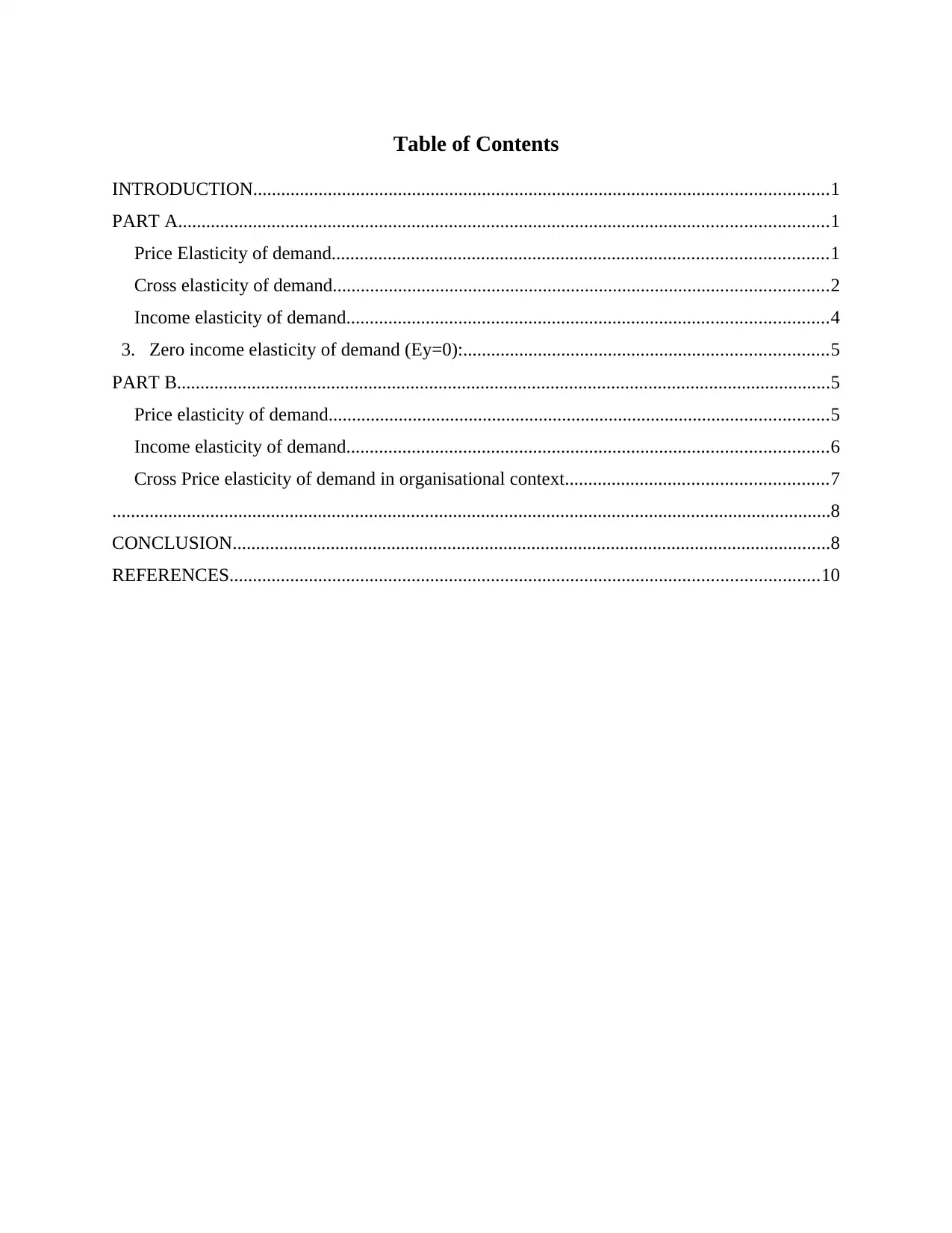
Table of Contents
INTRODUCTION...........................................................................................................................1
PART A...........................................................................................................................................1
Price Elasticity of demand..........................................................................................................1
Cross elasticity of demand..........................................................................................................2
Income elasticity of demand.......................................................................................................4
3. Zero income elasticity of demand (Ey=0):..............................................................................5
PART B............................................................................................................................................5
Price elasticity of demand...........................................................................................................5
Income elasticity of demand.......................................................................................................6
Cross Price elasticity of demand in organisational context........................................................7
..........................................................................................................................................................8
CONCLUSION................................................................................................................................8
REFERENCES..............................................................................................................................10
INTRODUCTION...........................................................................................................................1
PART A...........................................................................................................................................1
Price Elasticity of demand..........................................................................................................1
Cross elasticity of demand..........................................................................................................2
Income elasticity of demand.......................................................................................................4
3. Zero income elasticity of demand (Ey=0):..............................................................................5
PART B............................................................................................................................................5
Price elasticity of demand...........................................................................................................5
Income elasticity of demand.......................................................................................................6
Cross Price elasticity of demand in organisational context........................................................7
..........................................................................................................................................................8
CONCLUSION................................................................................................................................8
REFERENCES..............................................................................................................................10
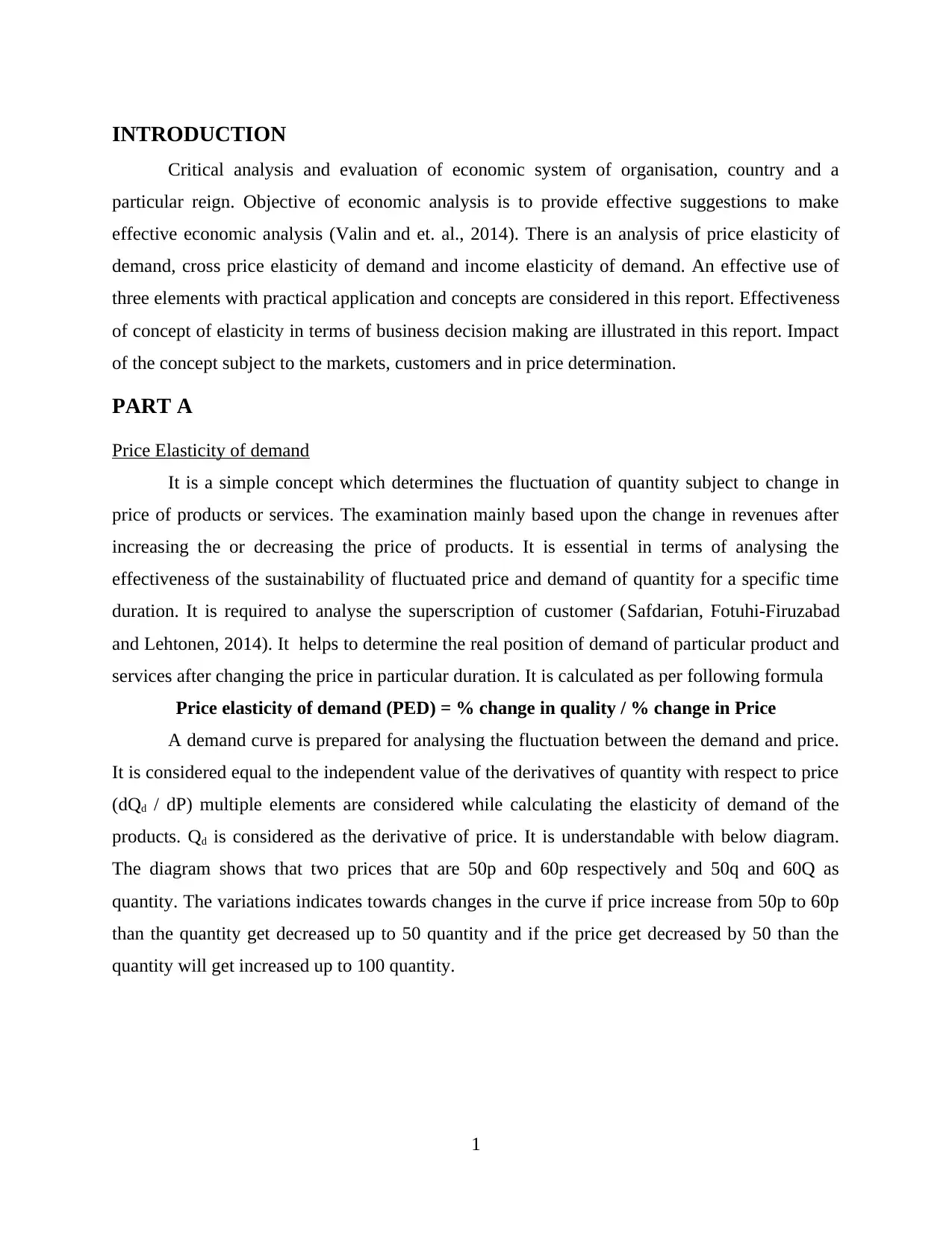
INTRODUCTION
Critical analysis and evaluation of economic system of organisation, country and a
particular reign. Objective of economic analysis is to provide effective suggestions to make
effective economic analysis (Valin and et. al., 2014). There is an analysis of price elasticity of
demand, cross price elasticity of demand and income elasticity of demand. An effective use of
three elements with practical application and concepts are considered in this report. Effectiveness
of concept of elasticity in terms of business decision making are illustrated in this report. Impact
of the concept subject to the markets, customers and in price determination.
PART A
Price Elasticity of demand
It is a simple concept which determines the fluctuation of quantity subject to change in
price of products or services. The examination mainly based upon the change in revenues after
increasing the or decreasing the price of products. It is essential in terms of analysing the
effectiveness of the sustainability of fluctuated price and demand of quantity for a specific time
duration. It is required to analyse the superscription of customer (Safdarian, Fotuhi-Firuzabad
and Lehtonen, 2014). It helps to determine the real position of demand of particular product and
services after changing the price in particular duration. It is calculated as per following formula
Price elasticity of demand (PED) = % change in quality / % change in Price
A demand curve is prepared for analysing the fluctuation between the demand and price.
It is considered equal to the independent value of the derivatives of quantity with respect to price
(dQd / dP) multiple elements are considered while calculating the elasticity of demand of the
products. Qd is considered as the derivative of price. It is understandable with below diagram.
The diagram shows that two prices that are 50p and 60p respectively and 50q and 60Q as
quantity. The variations indicates towards changes in the curve if price increase from 50p to 60p
than the quantity get decreased up to 50 quantity and if the price get decreased by 50 than the
quantity will get increased up to 100 quantity.
1
Critical analysis and evaluation of economic system of organisation, country and a
particular reign. Objective of economic analysis is to provide effective suggestions to make
effective economic analysis (Valin and et. al., 2014). There is an analysis of price elasticity of
demand, cross price elasticity of demand and income elasticity of demand. An effective use of
three elements with practical application and concepts are considered in this report. Effectiveness
of concept of elasticity in terms of business decision making are illustrated in this report. Impact
of the concept subject to the markets, customers and in price determination.
PART A
Price Elasticity of demand
It is a simple concept which determines the fluctuation of quantity subject to change in
price of products or services. The examination mainly based upon the change in revenues after
increasing the or decreasing the price of products. It is essential in terms of analysing the
effectiveness of the sustainability of fluctuated price and demand of quantity for a specific time
duration. It is required to analyse the superscription of customer (Safdarian, Fotuhi-Firuzabad
and Lehtonen, 2014). It helps to determine the real position of demand of particular product and
services after changing the price in particular duration. It is calculated as per following formula
Price elasticity of demand (PED) = % change in quality / % change in Price
A demand curve is prepared for analysing the fluctuation between the demand and price.
It is considered equal to the independent value of the derivatives of quantity with respect to price
(dQd / dP) multiple elements are considered while calculating the elasticity of demand of the
products. Qd is considered as the derivative of price. It is understandable with below diagram.
The diagram shows that two prices that are 50p and 60p respectively and 50q and 60Q as
quantity. The variations indicates towards changes in the curve if price increase from 50p to 60p
than the quantity get decreased up to 50 quantity and if the price get decreased by 50 than the
quantity will get increased up to 100 quantity.
1
⊘ This is a preview!⊘
Do you want full access?
Subscribe today to unlock all pages.

Trusted by 1+ million students worldwide
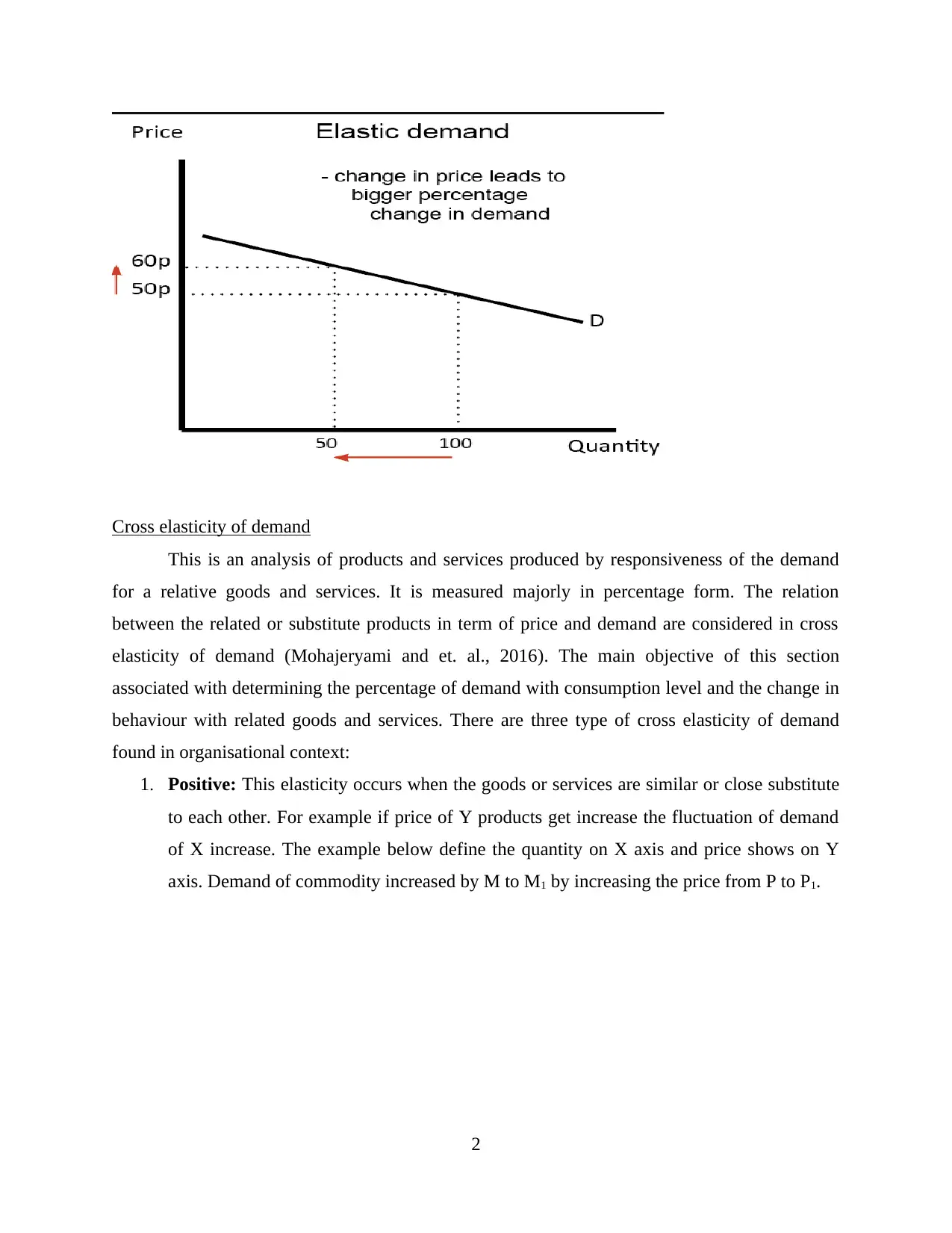
Cross elasticity of demand
This is an analysis of products and services produced by responsiveness of the demand
for a relative goods and services. It is measured majorly in percentage form. The relation
between the related or substitute products in term of price and demand are considered in cross
elasticity of demand (Mohajeryami and et. al., 2016). The main objective of this section
associated with determining the percentage of demand with consumption level and the change in
behaviour with related goods and services. There are three type of cross elasticity of demand
found in organisational context:
1. Positive: This elasticity occurs when the goods or services are similar or close substitute
to each other. For example if price of Y products get increase the fluctuation of demand
of X increase. The example below define the quantity on X axis and price shows on Y
axis. Demand of commodity increased by M to M1 by increasing the price from P to P1.
2
This is an analysis of products and services produced by responsiveness of the demand
for a relative goods and services. It is measured majorly in percentage form. The relation
between the related or substitute products in term of price and demand are considered in cross
elasticity of demand (Mohajeryami and et. al., 2016). The main objective of this section
associated with determining the percentage of demand with consumption level and the change in
behaviour with related goods and services. There are three type of cross elasticity of demand
found in organisational context:
1. Positive: This elasticity occurs when the goods or services are similar or close substitute
to each other. For example if price of Y products get increase the fluctuation of demand
of X increase. The example below define the quantity on X axis and price shows on Y
axis. Demand of commodity increased by M to M1 by increasing the price from P to P1.
2
Paraphrase This Document
Need a fresh take? Get an instant paraphrase of this document with our AI Paraphraser
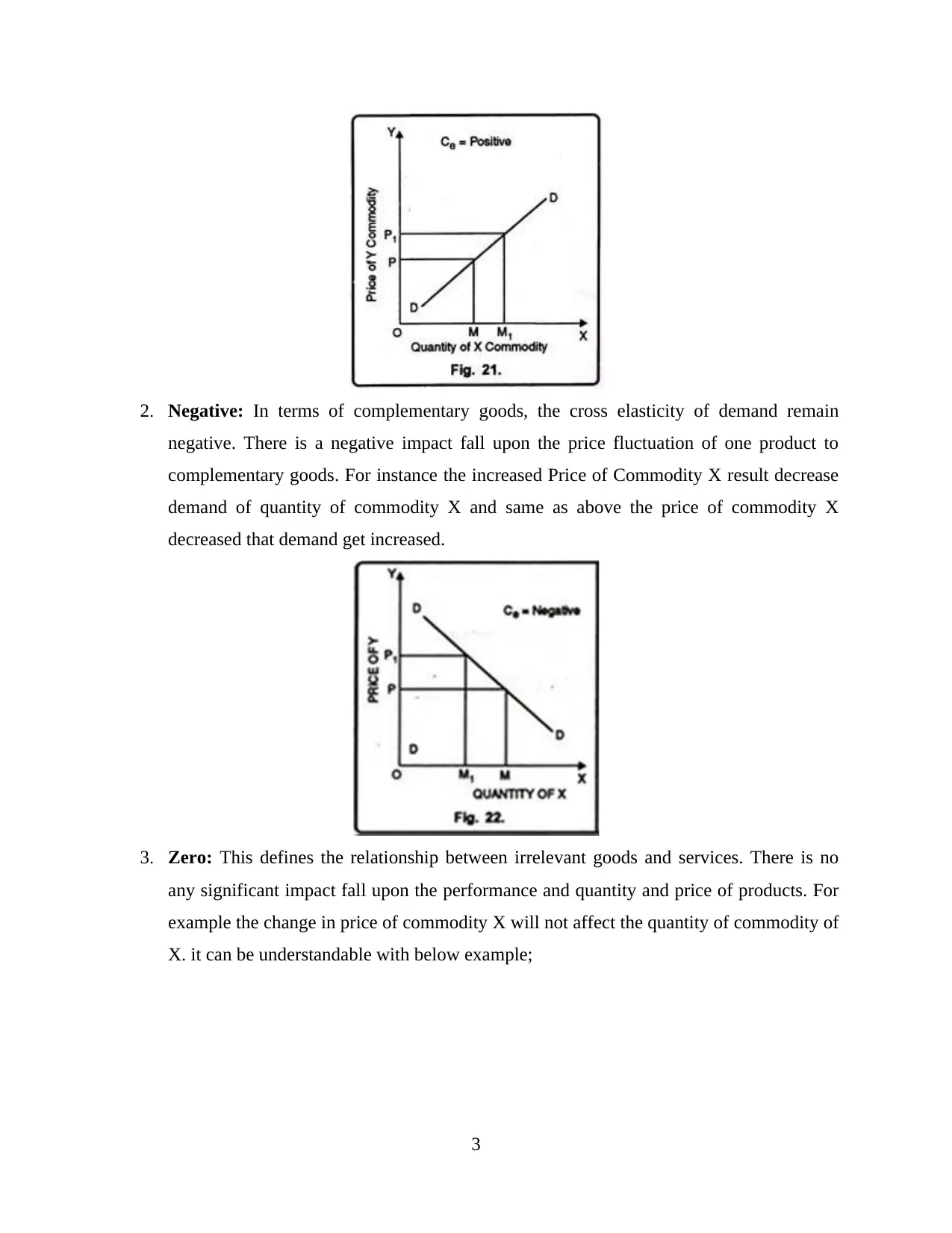
2. Negative: In terms of complementary goods, the cross elasticity of demand remain
negative. There is a negative impact fall upon the price fluctuation of one product to
complementary goods. For instance the increased Price of Commodity X result decrease
demand of quantity of commodity X and same as above the price of commodity X
decreased that demand get increased.
3. Zero: This defines the relationship between irrelevant goods and services. There is no
any significant impact fall upon the performance and quantity and price of products. For
example the change in price of commodity X will not affect the quantity of commodity of
X. it can be understandable with below example;
3
negative. There is a negative impact fall upon the price fluctuation of one product to
complementary goods. For instance the increased Price of Commodity X result decrease
demand of quantity of commodity X and same as above the price of commodity X
decreased that demand get increased.
3. Zero: This defines the relationship between irrelevant goods and services. There is no
any significant impact fall upon the performance and quantity and price of products. For
example the change in price of commodity X will not affect the quantity of commodity of
X. it can be understandable with below example;
3
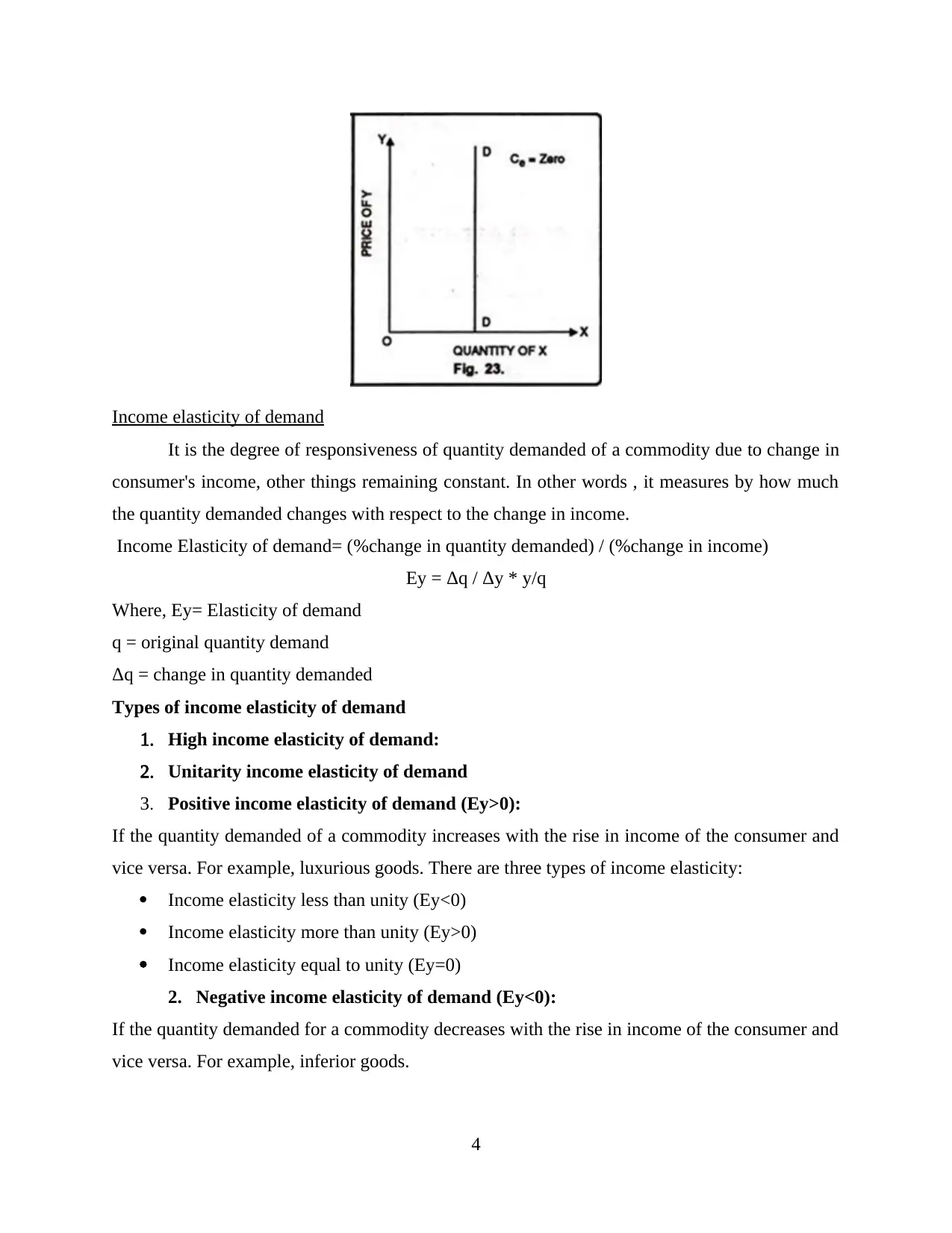
Income elasticity of demand
It is the degree of responsiveness of quantity demanded of a commodity due to change in
consumer's income, other things remaining constant. In other words , it measures by how much
the quantity demanded changes with respect to the change in income.
Income Elasticity of demand= (%change in quantity demanded) / (%change in income)
Ey = Δq / Δy * y/q
Where, Ey= Elasticity of demand
q = original quantity demand
Δq = change in quantity demanded
Types of income elasticity of demand
1. High income elasticity of demand:
2. Unitarity income elasticity of demand
3. Positive income elasticity of demand (Ey>0):
If the quantity demanded of a commodity increases with the rise in income of the consumer and
vice versa. For example, luxurious goods. There are three types of income elasticity:
Income elasticity less than unity (Ey<0)
Income elasticity more than unity (Ey>0)
Income elasticity equal to unity (Ey=0)
2. Negative income elasticity of demand (Ey<0):
If the quantity demanded for a commodity decreases with the rise in income of the consumer and
vice versa. For example, inferior goods.
4
It is the degree of responsiveness of quantity demanded of a commodity due to change in
consumer's income, other things remaining constant. In other words , it measures by how much
the quantity demanded changes with respect to the change in income.
Income Elasticity of demand= (%change in quantity demanded) / (%change in income)
Ey = Δq / Δy * y/q
Where, Ey= Elasticity of demand
q = original quantity demand
Δq = change in quantity demanded
Types of income elasticity of demand
1. High income elasticity of demand:
2. Unitarity income elasticity of demand
3. Positive income elasticity of demand (Ey>0):
If the quantity demanded of a commodity increases with the rise in income of the consumer and
vice versa. For example, luxurious goods. There are three types of income elasticity:
Income elasticity less than unity (Ey<0)
Income elasticity more than unity (Ey>0)
Income elasticity equal to unity (Ey=0)
2. Negative income elasticity of demand (Ey<0):
If the quantity demanded for a commodity decreases with the rise in income of the consumer and
vice versa. For example, inferior goods.
4
⊘ This is a preview!⊘
Do you want full access?
Subscribe today to unlock all pages.

Trusted by 1+ million students worldwide
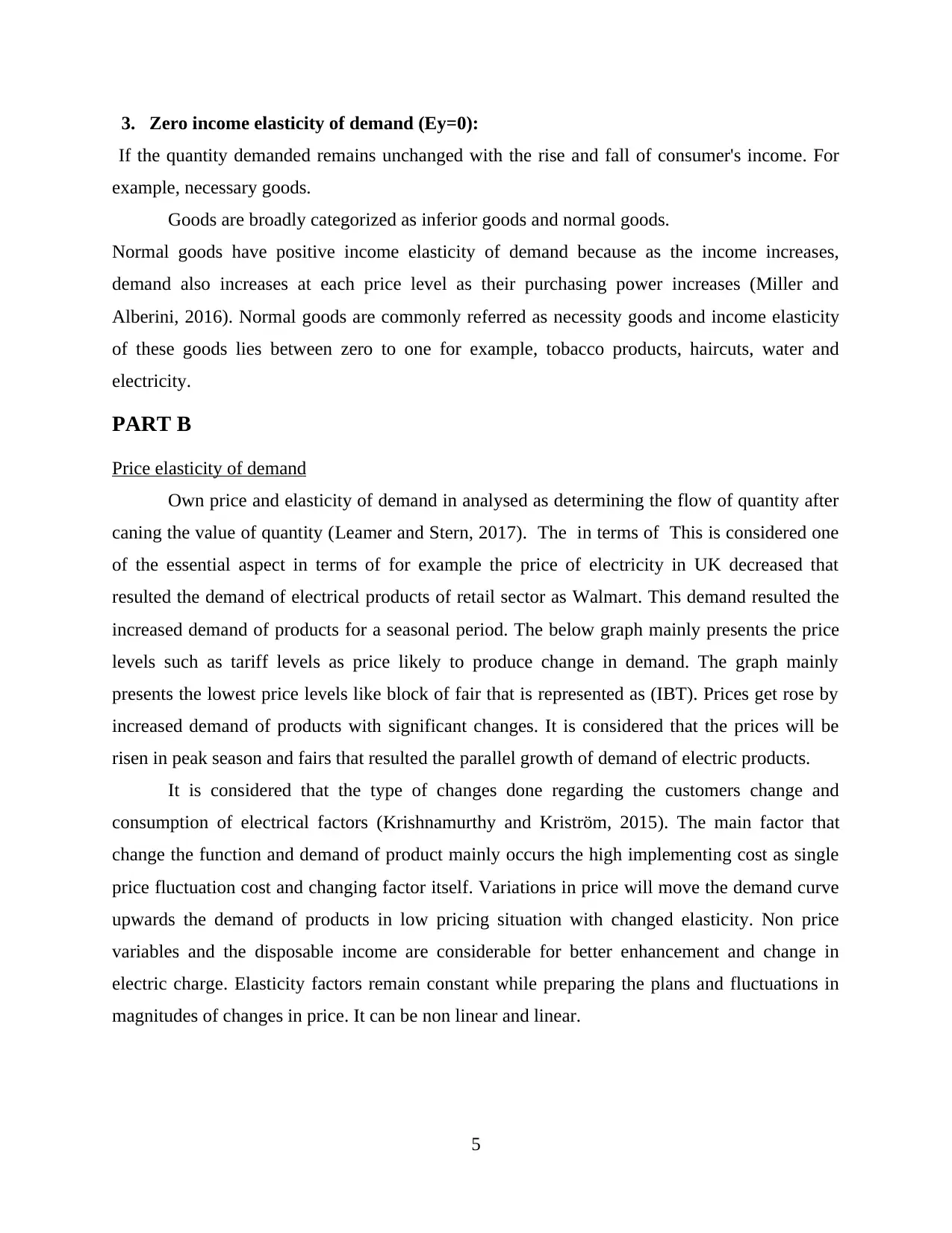
3. Zero income elasticity of demand (Ey=0):
If the quantity demanded remains unchanged with the rise and fall of consumer's income. For
example, necessary goods.
Goods are broadly categorized as inferior goods and normal goods.
Normal goods have positive income elasticity of demand because as the income increases,
demand also increases at each price level as their purchasing power increases (Miller and
Alberini, 2016). Normal goods are commonly referred as necessity goods and income elasticity
of these goods lies between zero to one for example, tobacco products, haircuts, water and
electricity.
PART B
Price elasticity of demand
Own price and elasticity of demand in analysed as determining the flow of quantity after
caning the value of quantity (Leamer and Stern, 2017). The in terms of This is considered one
of the essential aspect in terms of for example the price of electricity in UK decreased that
resulted the demand of electrical products of retail sector as Walmart. This demand resulted the
increased demand of products for a seasonal period. The below graph mainly presents the price
levels such as tariff levels as price likely to produce change in demand. The graph mainly
presents the lowest price levels like block of fair that is represented as (IBT). Prices get rose by
increased demand of products with significant changes. It is considered that the prices will be
risen in peak season and fairs that resulted the parallel growth of demand of electric products.
It is considered that the type of changes done regarding the customers change and
consumption of electrical factors (Krishnamurthy and Kriström, 2015). The main factor that
change the function and demand of product mainly occurs the high implementing cost as single
price fluctuation cost and changing factor itself. Variations in price will move the demand curve
upwards the demand of products in low pricing situation with changed elasticity. Non price
variables and the disposable income are considerable for better enhancement and change in
electric charge. Elasticity factors remain constant while preparing the plans and fluctuations in
magnitudes of changes in price. It can be non linear and linear.
5
If the quantity demanded remains unchanged with the rise and fall of consumer's income. For
example, necessary goods.
Goods are broadly categorized as inferior goods and normal goods.
Normal goods have positive income elasticity of demand because as the income increases,
demand also increases at each price level as their purchasing power increases (Miller and
Alberini, 2016). Normal goods are commonly referred as necessity goods and income elasticity
of these goods lies between zero to one for example, tobacco products, haircuts, water and
electricity.
PART B
Price elasticity of demand
Own price and elasticity of demand in analysed as determining the flow of quantity after
caning the value of quantity (Leamer and Stern, 2017). The in terms of This is considered one
of the essential aspect in terms of for example the price of electricity in UK decreased that
resulted the demand of electrical products of retail sector as Walmart. This demand resulted the
increased demand of products for a seasonal period. The below graph mainly presents the price
levels such as tariff levels as price likely to produce change in demand. The graph mainly
presents the lowest price levels like block of fair that is represented as (IBT). Prices get rose by
increased demand of products with significant changes. It is considered that the prices will be
risen in peak season and fairs that resulted the parallel growth of demand of electric products.
It is considered that the type of changes done regarding the customers change and
consumption of electrical factors (Krishnamurthy and Kriström, 2015). The main factor that
change the function and demand of product mainly occurs the high implementing cost as single
price fluctuation cost and changing factor itself. Variations in price will move the demand curve
upwards the demand of products in low pricing situation with changed elasticity. Non price
variables and the disposable income are considerable for better enhancement and change in
electric charge. Elasticity factors remain constant while preparing the plans and fluctuations in
magnitudes of changes in price. It can be non linear and linear.
5
Paraphrase This Document
Need a fresh take? Get an instant paraphrase of this document with our AI Paraphraser
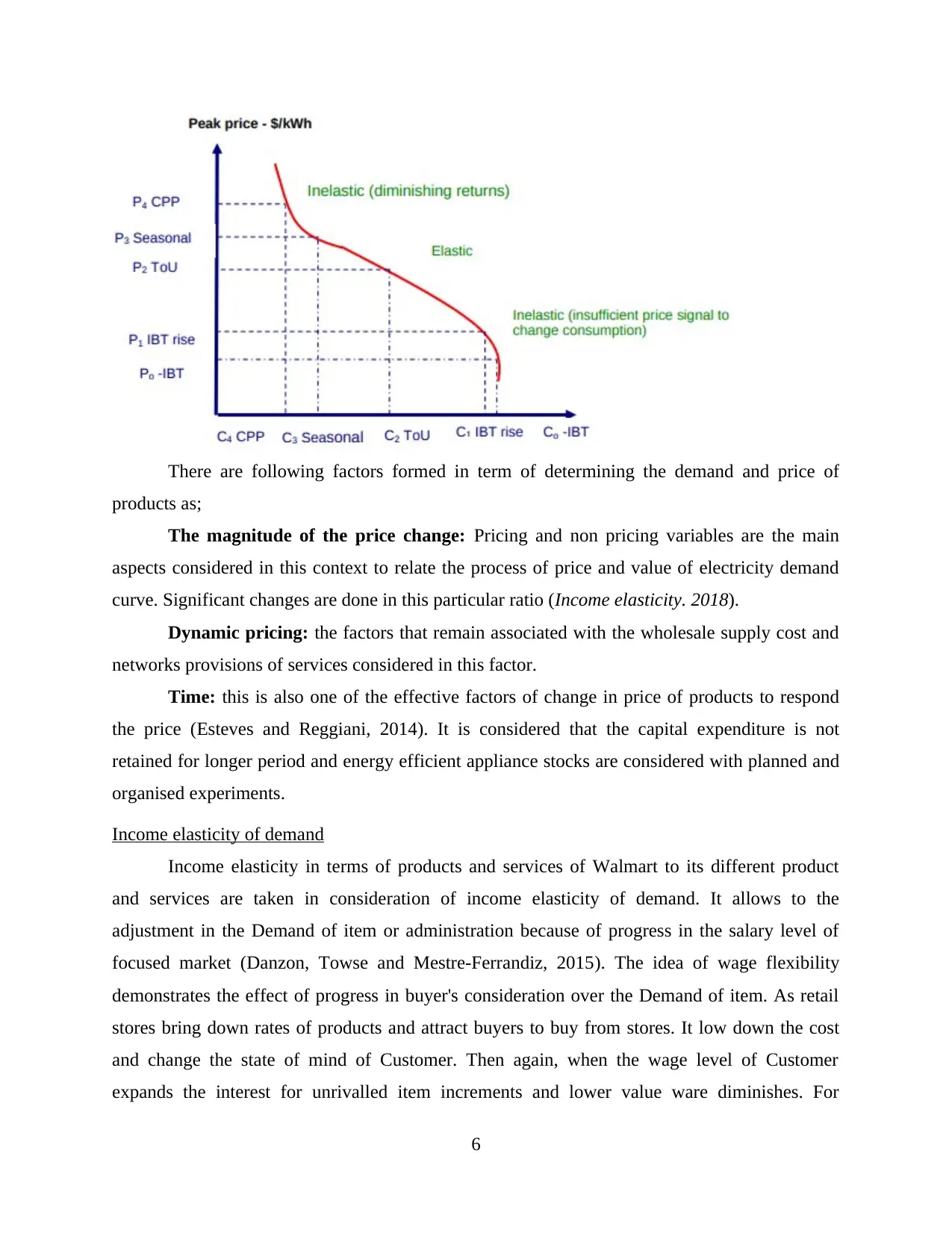
There are following factors formed in term of determining the demand and price of
products as;
The magnitude of the price change: Pricing and non pricing variables are the main
aspects considered in this context to relate the process of price and value of electricity demand
curve. Significant changes are done in this particular ratio (Income elasticity. 2018).
Dynamic pricing: the factors that remain associated with the wholesale supply cost and
networks provisions of services considered in this factor.
Time: this is also one of the effective factors of change in price of products to respond
the price (Esteves and Reggiani, 2014). It is considered that the capital expenditure is not
retained for longer period and energy efficient appliance stocks are considered with planned and
organised experiments.
Income elasticity of demand
Income elasticity in terms of products and services of Walmart to its different product
and services are taken in consideration of income elasticity of demand. It allows to the
adjustment in the Demand of item or administration because of progress in the salary level of
focused market (Danzon, Towse and Mestre‐Ferrandiz, 2015). The idea of wage flexibility
demonstrates the effect of progress in buyer's consideration over the Demand of item. As retail
stores bring down rates of products and attract buyers to buy from stores. It low down the cost
and change the state of mind of Customer. Then again, when the wage level of Customer
expands the interest for unrivalled item increments and lower value ware diminishes. For
6
products as;
The magnitude of the price change: Pricing and non pricing variables are the main
aspects considered in this context to relate the process of price and value of electricity demand
curve. Significant changes are done in this particular ratio (Income elasticity. 2018).
Dynamic pricing: the factors that remain associated with the wholesale supply cost and
networks provisions of services considered in this factor.
Time: this is also one of the effective factors of change in price of products to respond
the price (Esteves and Reggiani, 2014). It is considered that the capital expenditure is not
retained for longer period and energy efficient appliance stocks are considered with planned and
organised experiments.
Income elasticity of demand
Income elasticity in terms of products and services of Walmart to its different product
and services are taken in consideration of income elasticity of demand. It allows to the
adjustment in the Demand of item or administration because of progress in the salary level of
focused market (Danzon, Towse and Mestre‐Ferrandiz, 2015). The idea of wage flexibility
demonstrates the effect of progress in buyer's consideration over the Demand of item. As retail
stores bring down rates of products and attract buyers to buy from stores. It low down the cost
and change the state of mind of Customer. Then again, when the wage level of Customer
expands the interest for unrivalled item increments and lower value ware diminishes. For
6
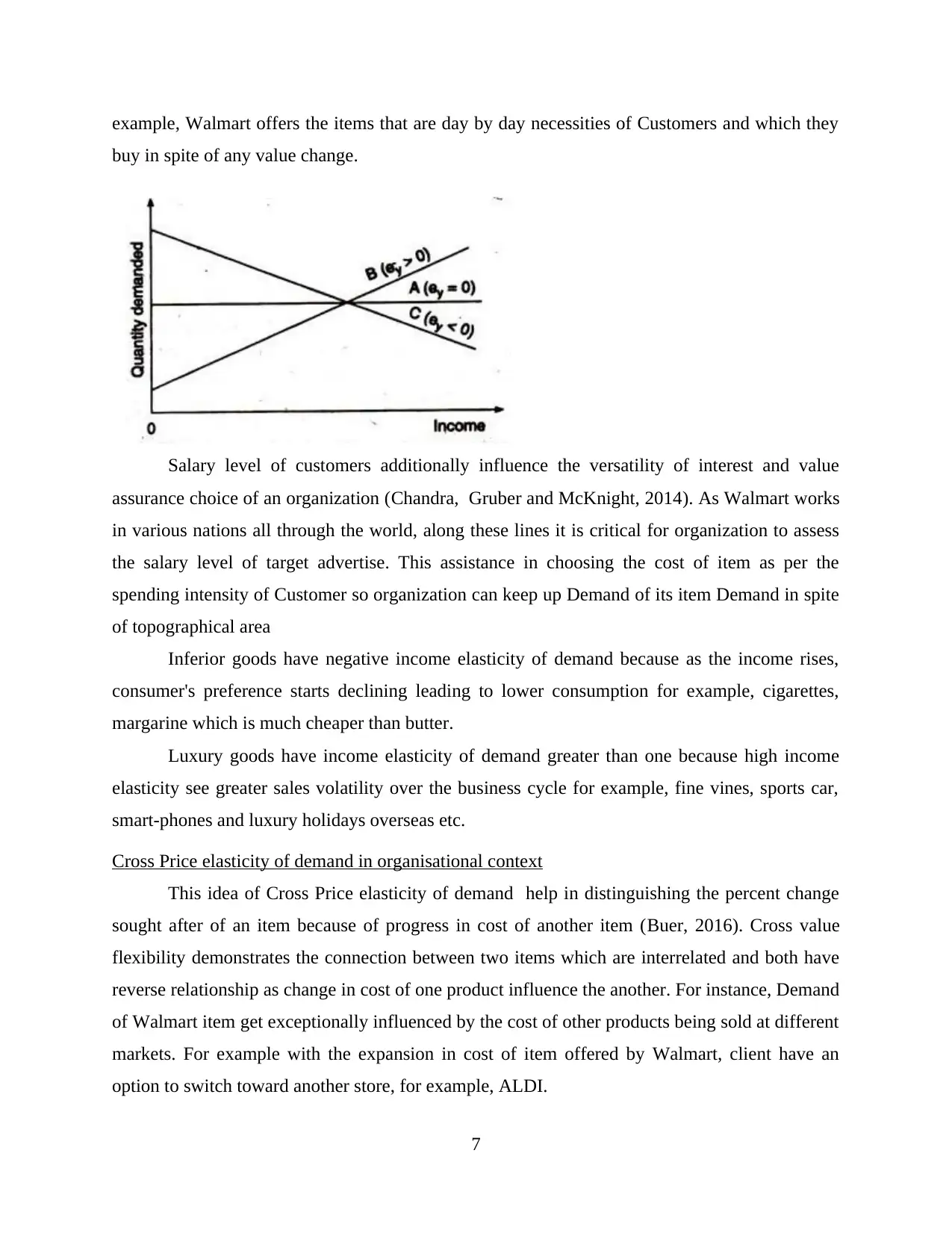
example, Walmart offers the items that are day by day necessities of Customers and which they
buy in spite of any value change.
Salary level of customers additionally influence the versatility of interest and value
assurance choice of an organization (Chandra, Gruber and McKnight, 2014). As Walmart works
in various nations all through the world, along these lines it is critical for organization to assess
the salary level of target advertise. This assistance in choosing the cost of item as per the
spending intensity of Customer so organization can keep up Demand of its item Demand in spite
of topographical area
Inferior goods have negative income elasticity of demand because as the income rises,
consumer's preference starts declining leading to lower consumption for example, cigarettes,
margarine which is much cheaper than butter.
Luxury goods have income elasticity of demand greater than one because high income
elasticity see greater sales volatility over the business cycle for example, fine vines, sports car,
smart-phones and luxury holidays overseas etc.
Cross Price elasticity of demand in organisational context
This idea of Cross Price elasticity of demand help in distinguishing the percent change
sought after of an item because of progress in cost of another item (Buer, 2016). Cross value
flexibility demonstrates the connection between two items which are interrelated and both have
reverse relationship as change in cost of one product influence the another. For instance, Demand
of Walmart item get exceptionally influenced by the cost of other products being sold at different
markets. For example with the expansion in cost of item offered by Walmart, client have an
option to switch toward another store, for example, ALDI.
7
buy in spite of any value change.
Salary level of customers additionally influence the versatility of interest and value
assurance choice of an organization (Chandra, Gruber and McKnight, 2014). As Walmart works
in various nations all through the world, along these lines it is critical for organization to assess
the salary level of target advertise. This assistance in choosing the cost of item as per the
spending intensity of Customer so organization can keep up Demand of its item Demand in spite
of topographical area
Inferior goods have negative income elasticity of demand because as the income rises,
consumer's preference starts declining leading to lower consumption for example, cigarettes,
margarine which is much cheaper than butter.
Luxury goods have income elasticity of demand greater than one because high income
elasticity see greater sales volatility over the business cycle for example, fine vines, sports car,
smart-phones and luxury holidays overseas etc.
Cross Price elasticity of demand in organisational context
This idea of Cross Price elasticity of demand help in distinguishing the percent change
sought after of an item because of progress in cost of another item (Buer, 2016). Cross value
flexibility demonstrates the connection between two items which are interrelated and both have
reverse relationship as change in cost of one product influence the another. For instance, Demand
of Walmart item get exceptionally influenced by the cost of other products being sold at different
markets. For example with the expansion in cost of item offered by Walmart, client have an
option to switch toward another store, for example, ALDI.
7
⊘ This is a preview!⊘
Do you want full access?
Subscribe today to unlock all pages.

Trusted by 1+ million students worldwide
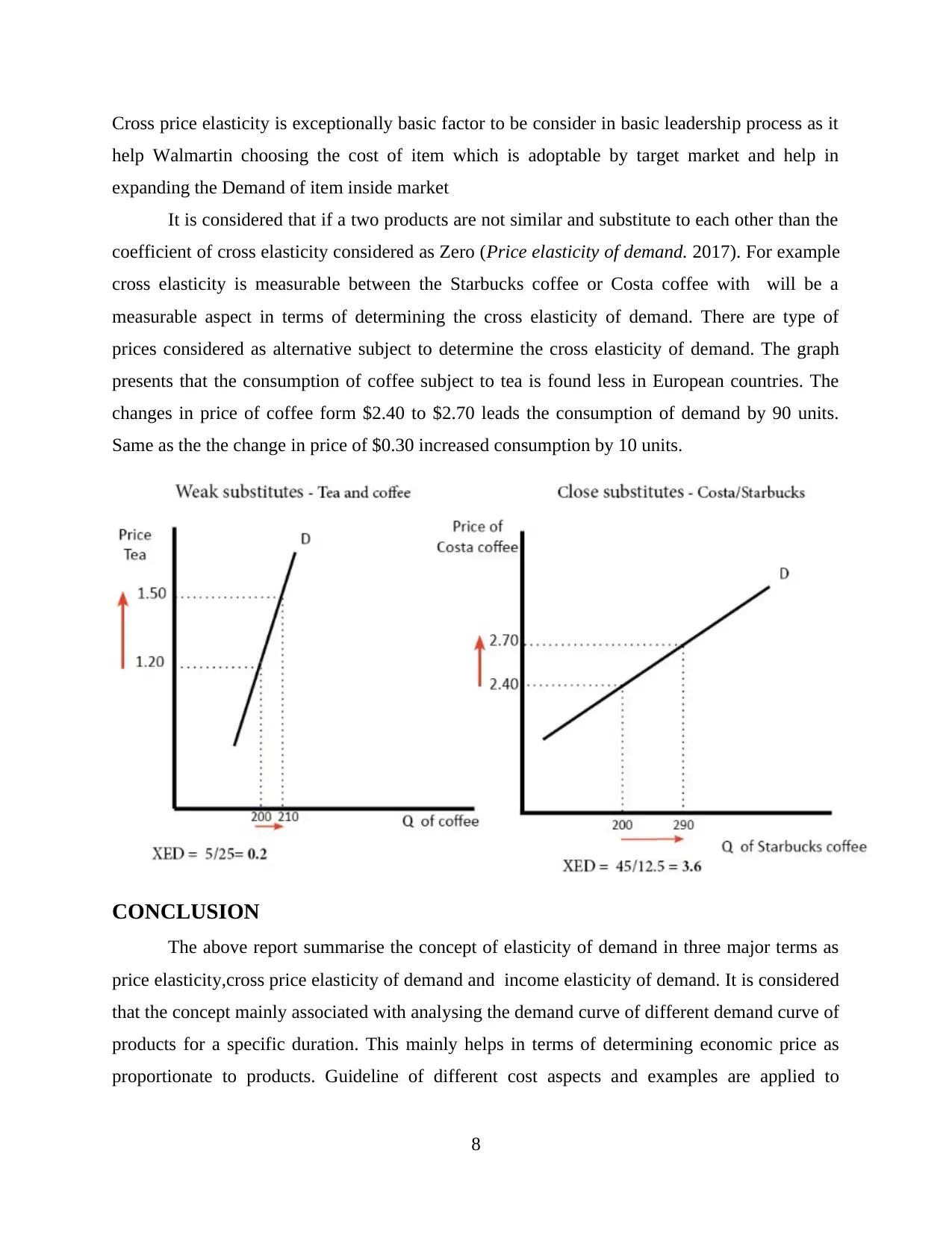
Cross price elasticity is exceptionally basic factor to be consider in basic leadership process as it
help Walmartin choosing the cost of item which is adoptable by target market and help in
expanding the Demand of item inside market
It is considered that if a two products are not similar and substitute to each other than the
coefficient of cross elasticity considered as Zero (Price elasticity of demand. 2017). For example
cross elasticity is measurable between the Starbucks coffee or Costa coffee with will be a
measurable aspect in terms of determining the cross elasticity of demand. There are type of
prices considered as alternative subject to determine the cross elasticity of demand. The graph
presents that the consumption of coffee subject to tea is found less in European countries. The
changes in price of coffee form $2.40 to $2.70 leads the consumption of demand by 90 units.
Same as the the change in price of $0.30 increased consumption by 10 units.
CONCLUSION
The above report summarise the concept of elasticity of demand in three major terms as
price elasticity,cross price elasticity of demand and income elasticity of demand. It is considered
that the concept mainly associated with analysing the demand curve of different demand curve of
products for a specific duration. This mainly helps in terms of determining economic price as
proportionate to products. Guideline of different cost aspects and examples are applied to
8
help Walmartin choosing the cost of item which is adoptable by target market and help in
expanding the Demand of item inside market
It is considered that if a two products are not similar and substitute to each other than the
coefficient of cross elasticity considered as Zero (Price elasticity of demand. 2017). For example
cross elasticity is measurable between the Starbucks coffee or Costa coffee with will be a
measurable aspect in terms of determining the cross elasticity of demand. There are type of
prices considered as alternative subject to determine the cross elasticity of demand. The graph
presents that the consumption of coffee subject to tea is found less in European countries. The
changes in price of coffee form $2.40 to $2.70 leads the consumption of demand by 90 units.
Same as the the change in price of $0.30 increased consumption by 10 units.
CONCLUSION
The above report summarise the concept of elasticity of demand in three major terms as
price elasticity,cross price elasticity of demand and income elasticity of demand. It is considered
that the concept mainly associated with analysing the demand curve of different demand curve of
products for a specific duration. This mainly helps in terms of determining economic price as
proportionate to products. Guideline of different cost aspects and examples are applied to
8
Paraphrase This Document
Need a fresh take? Get an instant paraphrase of this document with our AI Paraphraser
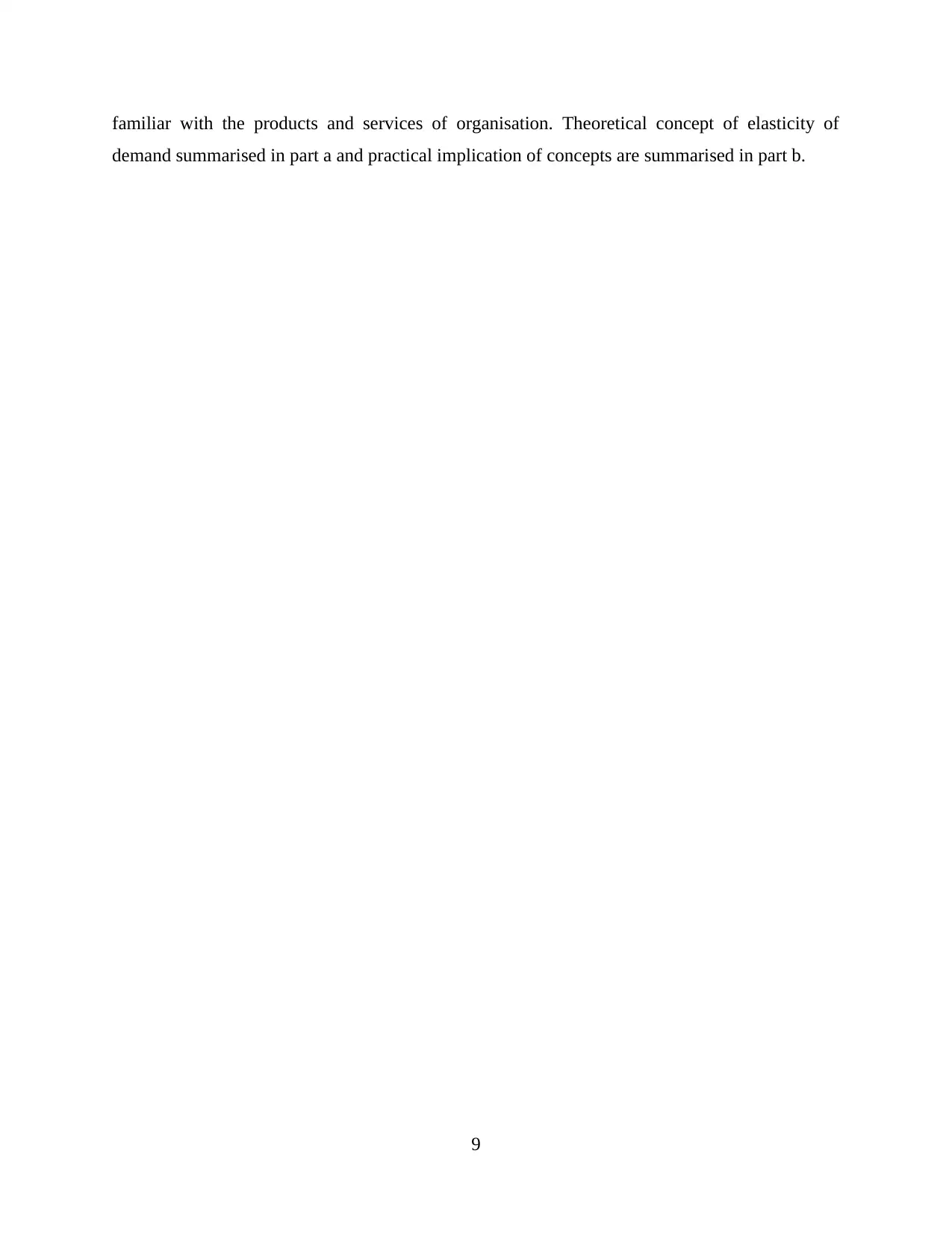
familiar with the products and services of organisation. Theoretical concept of elasticity of
demand summarised in part a and practical implication of concepts are summarised in part b.
9
demand summarised in part a and practical implication of concepts are summarised in part b.
9
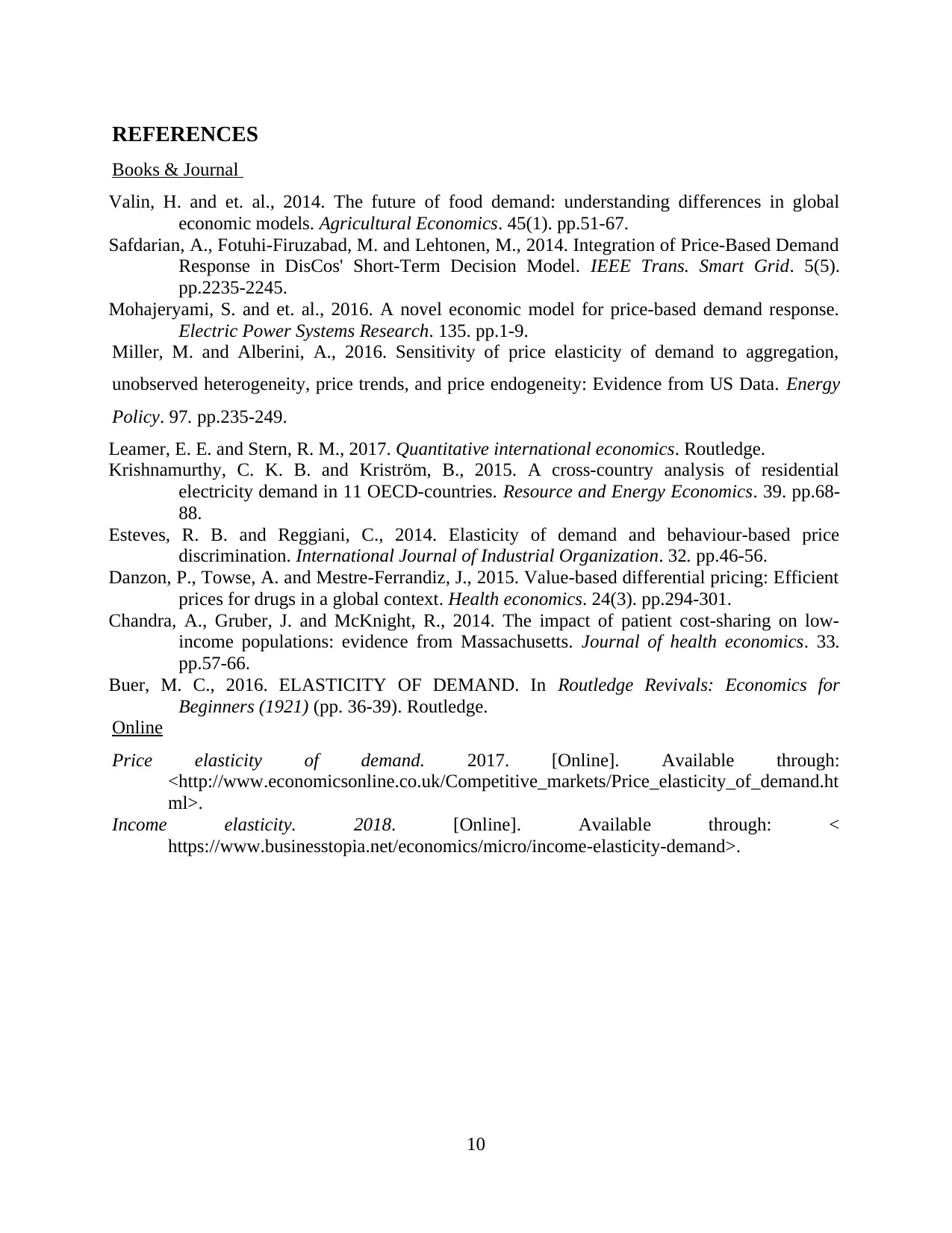
REFERENCES
Books & Journal
Valin, H. and et. al., 2014. The future of food demand: understanding differences in global
economic models. Agricultural Economics. 45(1). pp.51-67.
Safdarian, A., Fotuhi-Firuzabad, M. and Lehtonen, M., 2014. Integration of Price-Based Demand
Response in DisCos' Short-Term Decision Model. IEEE Trans. Smart Grid. 5(5).
pp.2235-2245.
Mohajeryami, S. and et. al., 2016. A novel economic model for price-based demand response.
Electric Power Systems Research. 135. pp.1-9.
Miller, M. and Alberini, A., 2016. Sensitivity of price elasticity of demand to aggregation,
unobserved heterogeneity, price trends, and price endogeneity: Evidence from US Data. Energy
Policy. 97. pp.235-249.
Leamer, E. E. and Stern, R. M., 2017. Quantitative international economics. Routledge.
Krishnamurthy, C. K. B. and Kriström, B., 2015. A cross-country analysis of residential
electricity demand in 11 OECD-countries. Resource and Energy Economics. 39. pp.68-
88.
Esteves, R. B. and Reggiani, C., 2014. Elasticity of demand and behaviour-based price
discrimination. International Journal of Industrial Organization. 32. pp.46-56.
Danzon, P., Towse, A. and Mestre‐Ferrandiz, J., 2015. Value‐based differential pricing: Efficient
prices for drugs in a global context. Health economics. 24(3). pp.294-301.
Chandra, A., Gruber, J. and McKnight, R., 2014. The impact of patient cost-sharing on low-
income populations: evidence from Massachusetts. Journal of health economics. 33.
pp.57-66.
Buer, M. C., 2016. ELASTICITY OF DEMAND. In Routledge Revivals: Economics for
Beginners (1921) (pp. 36-39). Routledge.
Online
Price elasticity of demand. 2017. [Online]. Available through:
<http://www.economicsonline.co.uk/Competitive_markets/Price_elasticity_of_demand.ht
ml>.
Income elasticity. 2018. [Online]. Available through: <
https://www.businesstopia.net/economics/micro/income-elasticity-demand>.
10
Books & Journal
Valin, H. and et. al., 2014. The future of food demand: understanding differences in global
economic models. Agricultural Economics. 45(1). pp.51-67.
Safdarian, A., Fotuhi-Firuzabad, M. and Lehtonen, M., 2014. Integration of Price-Based Demand
Response in DisCos' Short-Term Decision Model. IEEE Trans. Smart Grid. 5(5).
pp.2235-2245.
Mohajeryami, S. and et. al., 2016. A novel economic model for price-based demand response.
Electric Power Systems Research. 135. pp.1-9.
Miller, M. and Alberini, A., 2016. Sensitivity of price elasticity of demand to aggregation,
unobserved heterogeneity, price trends, and price endogeneity: Evidence from US Data. Energy
Policy. 97. pp.235-249.
Leamer, E. E. and Stern, R. M., 2017. Quantitative international economics. Routledge.
Krishnamurthy, C. K. B. and Kriström, B., 2015. A cross-country analysis of residential
electricity demand in 11 OECD-countries. Resource and Energy Economics. 39. pp.68-
88.
Esteves, R. B. and Reggiani, C., 2014. Elasticity of demand and behaviour-based price
discrimination. International Journal of Industrial Organization. 32. pp.46-56.
Danzon, P., Towse, A. and Mestre‐Ferrandiz, J., 2015. Value‐based differential pricing: Efficient
prices for drugs in a global context. Health economics. 24(3). pp.294-301.
Chandra, A., Gruber, J. and McKnight, R., 2014. The impact of patient cost-sharing on low-
income populations: evidence from Massachusetts. Journal of health economics. 33.
pp.57-66.
Buer, M. C., 2016. ELASTICITY OF DEMAND. In Routledge Revivals: Economics for
Beginners (1921) (pp. 36-39). Routledge.
Online
Price elasticity of demand. 2017. [Online]. Available through:
<http://www.economicsonline.co.uk/Competitive_markets/Price_elasticity_of_demand.ht
ml>.
Income elasticity. 2018. [Online]. Available through: <
https://www.businesstopia.net/economics/micro/income-elasticity-demand>.
10
⊘ This is a preview!⊘
Do you want full access?
Subscribe today to unlock all pages.

Trusted by 1+ million students worldwide
1 out of 12
Related Documents
Your All-in-One AI-Powered Toolkit for Academic Success.
+13062052269
info@desklib.com
Available 24*7 on WhatsApp / Email
![[object Object]](/_next/static/media/star-bottom.7253800d.svg)
Unlock your academic potential
Copyright © 2020–2025 A2Z Services. All Rights Reserved. Developed and managed by ZUCOL.





